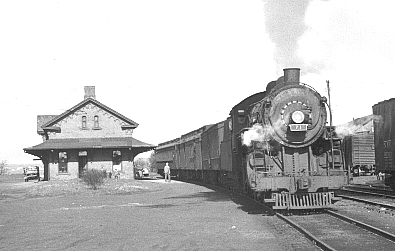A Remembering the Rutland Capsule History
MILK TRAIN
by Steve Mumley
Note: This capsule history was originally published in Volume V, Part 2 of Bob Nimke’s series of books "The Rutland 60 Years of Trying." It is re-published here with the kind permission of the author.
To study a brief account of an actual crew and consist for The Milk, refer to another of Steve's capsule histories: "Working the Milk with Johnnie McKean."Milk traffic on the Rutland Railroad made up a good share of revenue in the 1930's and '40's. The O&LC (Ogdensburg & Lake Champlain) or Ogdensburg sub-division was the beginning point for the milk train that rushed this traffic to the Boston and New York City markets. Train No. 8 would leave Ogdensburg at 6:45 a.m. making milk pickups at the following stations:
| Location | Description |
| Lisbon, NY | Bulk car |
| Norwood | Car from the Norwood & St. Lawrence RR |
| No. Lawrence | Bulk car from Borden Milk Co. |
| Bangor | Ice cream mix in cane |
| Morton Siding | (Malone) Bulk car |
| Burke | Bulk Part car - train waits for loading |
| Chateaugay | Cans - also set out loads for milk processing plant |
| Cherubusco | Bulk - part car |
| Ellenburg | Bulk car |
| Champlain | Cans (cream) |
| Alburgh, VT | Bulk car - Whiting Milk Co. |
During the steam era just about all the classes of Rutland steam power were used on the milk trains, with the 70 and 80 class engines seeing the most service [photos]. By 1952 milk trains No. 7 and No. 8 (the O&LC portions of the "Milk") had become diesel powered and then in turn became mixed trains because of decreasing milk shipments. During the diesel years, 400 class units were used.
No. 8 was scheduled to arrive in Alburgh at 12:45 p.m. However, because of the varying milk car switchings, No. 8 frequently missed the 12:45 p.m. arrival time. The train crew worked between Ogdensburg and Rutland except for the swing man (brakeman) who got off at Alburgh and would return on No. 7 to Ogdensburg the next day. No. 8 became No. 88 at Alburgh. It went to Rutland where a new crew would take over. At Rutland the train was split: No. 88 became No. 156 to Bellows Falls with the Boston cars while No. 88 went to Chatham, NY where a connection was made with the New York Central Railroad for delivery to New York City over the Harlem Division.
On the return trip, the trains ran as No. 159 Bellows Falls to Rutland (except on Sunday; No. 167 on Sunday); No. 83 Chatham to Rutland; No. 87 Rutland to Alburgh; No. 7 Alburgh to Ogdensburg. No. 7, which was due out of Alburgh at 3:10 p.m., would first back the train of empties into the Alburgh Lakeside Ice House for the ice during the summer months. The crew and ice house workers would place the ice in the ends of the cars for icing on the return trip the next day. During the winter months steam heat was used to keep the milk from freezing.
The milk train also carried passengers. A coach or combine was used for this purpose. The combine usually worked between Ogdensburg and Rutland, going with the crew. Three cars were available for such use and were numbered 253, 255, and 256. Combines 255 and 256 received the Rutland yellow and green paint scheme in their last few years of revenue service. (The 700 series steel and wood coaches were used both on the main line and on the O&LC).
At Norwood, NY No. 8 would make connection with the New York Central passenger train to Massena. If the Rutland was a little late the NYC would wait up to 15 minutes for No. 8. The milk trains also carried a baggage car and picked up and set out baggage and express along the way between Alburgh and Rutland.

One early morning in May of 1948, Preston S. Johnson found Rutland Ten
Wheeler #71 ready to start from Ogdensburg, NY with train No. 8 the "Milk."
Collection of Wayne D. Hills